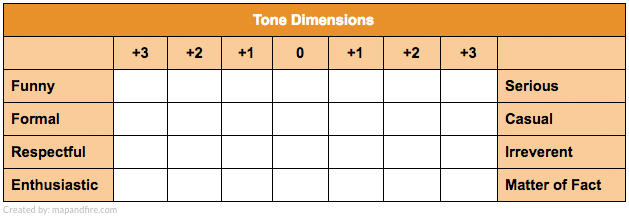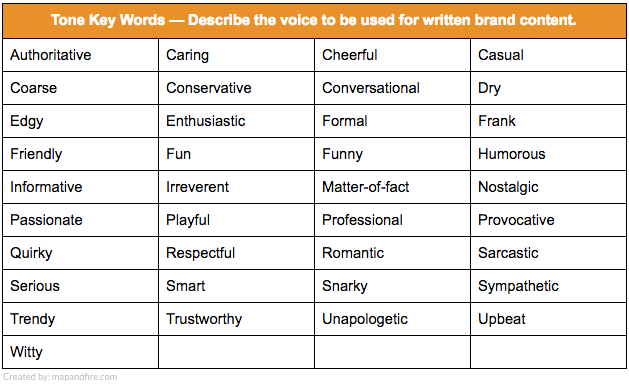
A key part of building trust with your brand’s audience is using a clear, consistent tone of voice with everything you write.
Whether it’s a website headline, newsletter, article, social post, or error message, they all need to sound like they came from the same source. When they don’t, it creates uncertainty with your audience. It means instead of focusing on what you’re saying, they’re thinking about how you’re saying it.

That distraction won’t help you convert the person into a customer.
Of course it’s one thing to say you want a “clear, consistent tone” and it’s another to define that tone and put it into practice.
Tone in particular is an inherently slippery part of your brand because it’s so complex. Go ahead and give it a shot. Try to articulate the feelings infused in your company’s messages.
Would you say they’re serious and matter-of-fact? Or maybe more funny? Or maybe not super funny, but occasionally witty? Or maybe it’s not so much witty, but actually kind of quirky.
It’s hard to keep it straight when it’s all in your head.
A solopreneur has a slight advantage with consistency because everything comes from one person. But solo business owners still need to establish a tone of voice for their company’s brand. It’s easy (and dangerous) to assume your personal tone naturally aligns with what’s best for your company.
For bigger companies, with lots of different roles, defining your tone is the only way to keep everyone on the same page. Otherwise, one person may be thinking “funny”, another “witty”, and another “quirky”. And your audience won’t know what to think.
When defining your tone you’ll want a format that’s easy for everyone to understand, and ideally quantifiable in some way. Doing this allows for constructive discussions where you can actually explain why something “just doesn’t sound right” and make meaningful improvements
To address all of these needs, we’ve created two simple exercises to help you define your brand’s Tone of Voice.
To make these exercises effective, you’ll first need to think about what sort of tone is aligned with your customers’ needs. But as long as you know who you’re aiming for and what they value, these exercises will help crystallize how you define that tone.
The material for the exercises was adapted from research conducted by the Nielsen Norman Group. They explain the approach of their research in the articles: The Four Dimensions of Tone of Voice, and Tone of Voice Words.
Now, the exercises!
Exercise 1: Tone Dimensions
The first tone exercise involves choosing a position on four sets of opposite words.
For each of the four word pairings below, place an “X” in the box that best corresponds to the tone you desire for your business.

Exercise 2: Tone Keywords
Step 1: Highlight 4–6 words that describe your desired tone well.
Step 2: Strikethrough up to 6 words that do not describe your desired tone.

If you have co-founders or business partners, try having each person complete these exercises independently, and then compare answers. You’ll learn a lot in the process, and you might even be surprised at some of the differences.
Extra Credit: If you really want to make sure your tone is landing with your customers, the Nielsen Norman group encourages you to ask your customers to assign tone grades to your messaging as well. This can be a valuable exercise in trust building and alignment — again, you’re bound to get some valuable and maybe surprising feedback as a result.
Benefits of Defining Your Brand’s Tone of Voice
Here’s a quick recap of the benefits you can reap from taking the time to do this:
- You’ll get ideas about tone out of your head and into a document that can be discussed with your team to provide clarity and a deeper understanding of your company’s tone of voice
- Your tone exercises can act as a guide for those that are writing messaging to develop consistency for the brand
- You’ll establish a record of decisions that were made around tone so that they can be tested and improved on over time
- You’ll create a means of conducting user research to find out if your audience thinks about you in the same way you think about yourself
If you like this type of exercise to help define your brand, you can read more about how we use this as part of our Brand Guidebook process here.


